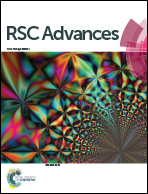Study of the temperature and solvent content effects on the structure of Cu–BTC metal organic framework for hydrogen storage
Abstract
Metal organic frameworks (MOFs) with intriguing structural motifs and unique properties are potential candidates for hydrogen storage. In this study, Cu–BTC (Copper (II) benzene-1,3,5-tricarboxylate) MOF was synthesized using an ultrasonication followed by reflux method. The influence of synthesis temperature (80, 110 and 140 °C) and solvent content (50, 75 and 100 ml DMF) on the structure and H2 storage performance of the developed MOFs was investigated. The structure of the synthesized MOFs was characterized by XRD, TGA/DSC, FE-SEM and BET analyses. Hydrogen adsorption performance of the developed MOFs was evaluated using a volumetric technique. The highest H2 uptake of 0.7 wt% was obtained with the sample synthesized at 80 °C with 75 ml DMF. The isosteric heat of adsorption was calculated by substitution of the Freundlich equation with temperature dependent parameters in the Clausius–Clapeyron equation. The isosteric heat of hydrogen adsorption monotonically decreased with surface loading. Also, the n-th order kinetic model was successfully applied to describe the experimental kinetic data in which the order of adsorption reaction was considered as an adjustable parameter. The value of 1.59 obtained for the order of the kinetic model indicated that the adsorption process mechanism followed a combination of physisorption and chemisorption.


 Please wait while we load your content...
Please wait while we load your content...